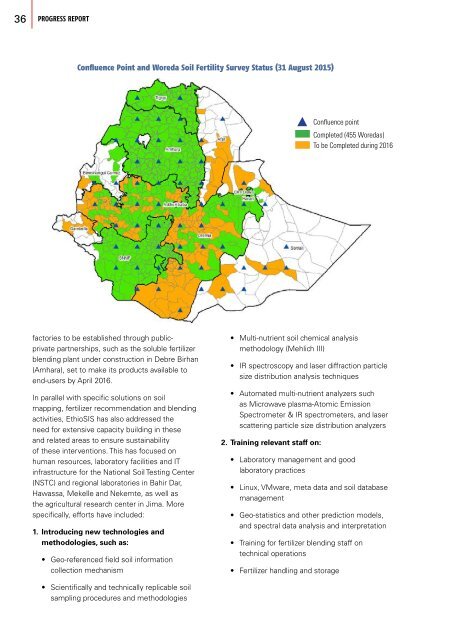PROGRESS REPORT
1LLMfQ4
1LLMfQ4
You also want an ePaper? Increase the reach of your titles
YUMPU automatically turns print PDFs into web optimized ePapers that Google loves.
36 <strong>PROGRESS</strong> <strong>REPORT</strong> PROGRAM LEVEL <strong>PROGRESS</strong> <strong>REPORT</strong> 37<br />
Confluence Point and Woreda Soil Fertility Survey Status (31 August 2015)<br />
Confluence point<br />
Completed (455 Woredas)<br />
To be Completed during 2016<br />
3. Investments in logistics and IT:<br />
• Ammonium Nitrate storage with a capacity<br />
of 20 terabytes to hold the EthioSIS master<br />
database and geo-statistical modeling data<br />
• One powerful satellite image processing<br />
server to enhance the processing capacity<br />
of the geo-statistical model<br />
• Arc GIS software for geo-statistical analysis<br />
and map making<br />
EthioSIS is a milestone in Ethiopia’s history of soil<br />
fertility analysis and fertilizer recommendations.<br />
Due to its considerable achievements, efforts<br />
are underway to streamline the project within<br />
the agriculture sector, beginning with the federal<br />
level and expanding its findings to contribute<br />
to livestock development, identifying soils that<br />
need special care, conducting land use planning,<br />
and preparing a soil resource data sharing policy,<br />
among others. In addition, work is underway to<br />
revise the fertilizer policy, strategy and production<br />
and marketing proclamation. Discussions are also<br />
underway to establish a fertilizer industry agency<br />
to regulate the fertilizer supply chain and quality.<br />
Finally, EthioSIS has begun to serve as a model<br />
for many other African countries with which it has<br />
shared its experiences, leading to preparations by<br />
Nigeria, Ghana and Tanzania to undertake similar<br />
initiatives.<br />
factories to be established through publicprivate<br />
partnerships, such as the soluble fertilizer<br />
blending plant under construction in Debre Birhan<br />
(Amhara), set to make its products available to<br />
end-users by April 2016.<br />
In parallel with specific solutions on soil<br />
mapping, fertilizer recommendation and blending<br />
activities, EthioSIS has also addressed the<br />
need for extensive capacity building in these<br />
and related areas to ensure sustainability<br />
of these interventions. This has focused on<br />
human resources, laboratory facilities and IT<br />
infrastructure for the National Soil Testing Center<br />
(NSTC) and regional laboratories in Bahir Dar,<br />
Hawassa, Mekelle and Nekemte, as well as<br />
the agricultural research center in Jima. More<br />
specifically, efforts have included:<br />
1. Introducing new technologies and<br />
methodologies, such as:<br />
• Geo-referenced field soil information<br />
collection mechanism<br />
• Multi-nutrient soil chemical analysis<br />
methodology (Mehlich III)<br />
• IR spectroscopy and laser diffraction particle<br />
size distribution analysis techniques<br />
• Automated multi-nutrient analyzers such<br />
as Microwave plasma-Atomic Emission<br />
Spectrometer & IR spectrometers, and laser<br />
scattering particle size distribution analyzers<br />
2. Training relevant staff on:<br />
• Laboratory management and good<br />
laboratory practices<br />
• Linux, VMware, meta data and soil database<br />
management<br />
• Geo-statistics and other prediction models,<br />
and spectral data analysis and interpretation<br />
• Training for fertilizer blending staff on<br />
technical operations<br />
• Fertilizer handling and storage<br />
• Scientifically and technically replicable soil<br />
sampling procedures and methodologies


